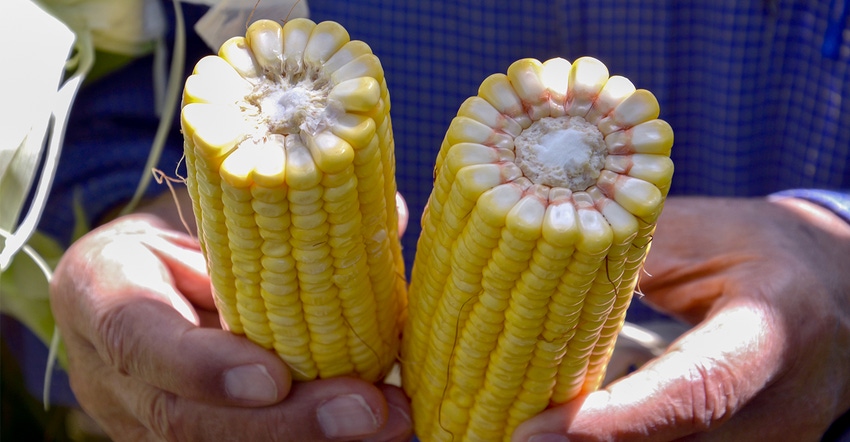
You’re looking at two ears of corn. One has more rows of kernels around the ear and sports a girthier cob. The other has a narrow cob and two fewer rows of kernels, but the kernels are longer and set deeper into the cob. Eye appeal says the hybrid with the girthier cob will produce more corn. Are your eyes right?
Dave Nanda says only the yield monitor will provide the answer. These two hybrids are planted in alternating blocks across the Corn Watch ’17 field. Nanda is an independent crops consultant based in Indianapolis. Corn Watch ’17 is sponsored by Seed Genetics-Direct, Washington Court House, Ohio.
The only way the hybrid with fewer rows can yield more is if the longer, deeper kernels fill out and add more weight. That means weather during grain fill became super critical. The field was flush with rain during the first half of the year, but then Mother Nature turned off the spigot in late July through mid-August. That could affect kernel fill, Nanda says. Of course it could affect how well kernels fill on the hybrid with the girthier ear, as well.
3 examples
Here are three potential yields for the same ears pulled from each hybrid in August. The standard method for estimating yields before harvest was used, including three different factors that take kernel size into account. Several years ago, 90 was the common factor, representing 90,000 kernels per bushel. Then Purdue University Extension corn specialist Bob Nielsen and others suggested using a different factor since kernels on modern hybrids tend to be larger. Some use 85 or 80. In years where grain fill is favorable, some believe a factor of 75 is more accurate.
Here are average numbers for Hybrid A, based on random sampling: 30,000 ears per acre, 14 rows of kernels per ear, 42 kernels per row. For Hybrid B: 30,000 ears per acre, 16 rows of kernels, 42 kernels per row.
Example 1: Use 90 as the factor related to kernel size.
Hybrid A: 30 x 14 x 42 = 17,640 / 90 = 196 bushels per acre
Hybrid B: 30 x 16 x 42 = 20,160 / 90 = 224 bushels per acre
Example 2: Use 85 as the factor.
Hybrid A: 30 x14 x 42 = 17,640 / 85 = 207.5 bushels per acre
Hybrid B: 30 x 16 x 42 = 20,160 / 85 = 237 bushels per acre
Example 3: Use 75 as the factor.
Hybrid A: 30 x 14 x 42 = 17,640 / 75 = 233 bushels per acre
Hybrid B: 30 x 16 x 42 = 20,160 / 75 = 269 bushels per acre
Easy winner?
Hybrid B won in every comparison. Suppose Hybrid A truly has an advantage in kernel depth. Compare Hybrid A with the factor of 75 vs. Hybrid B at 85.
Hybrid A: 30 x 14 x 42 = 17,640 / 75 = 233 bushels per acre
Hybrid B: 30 x 16 x 42 = 20,160 / 85 = 237 bushels per acre
Suddenly yields are so close, they might not be significantly different from each other.
Look for the “tale of the yield monitor” coming this fall!
About the Author(s)
You May Also Like




